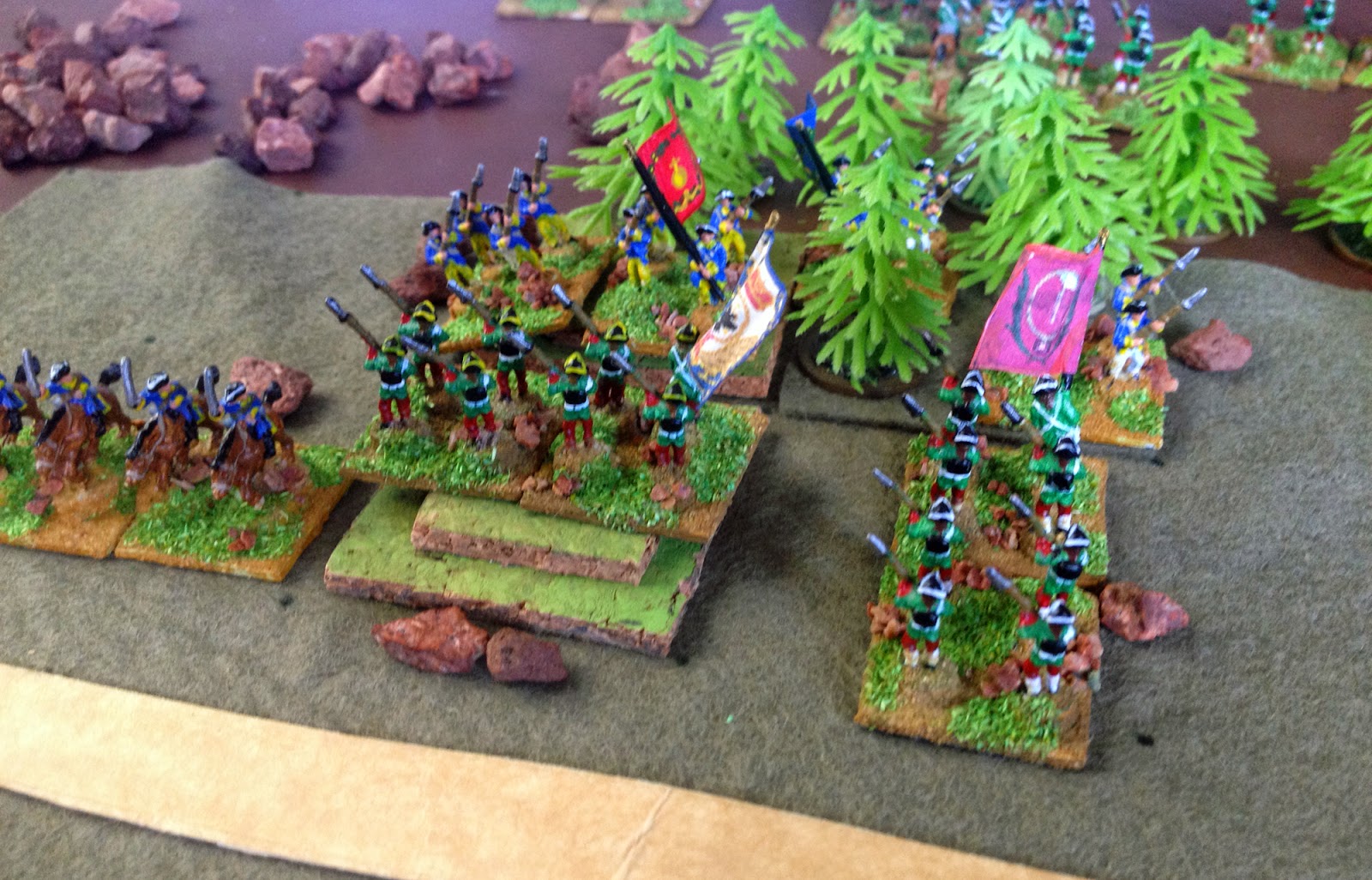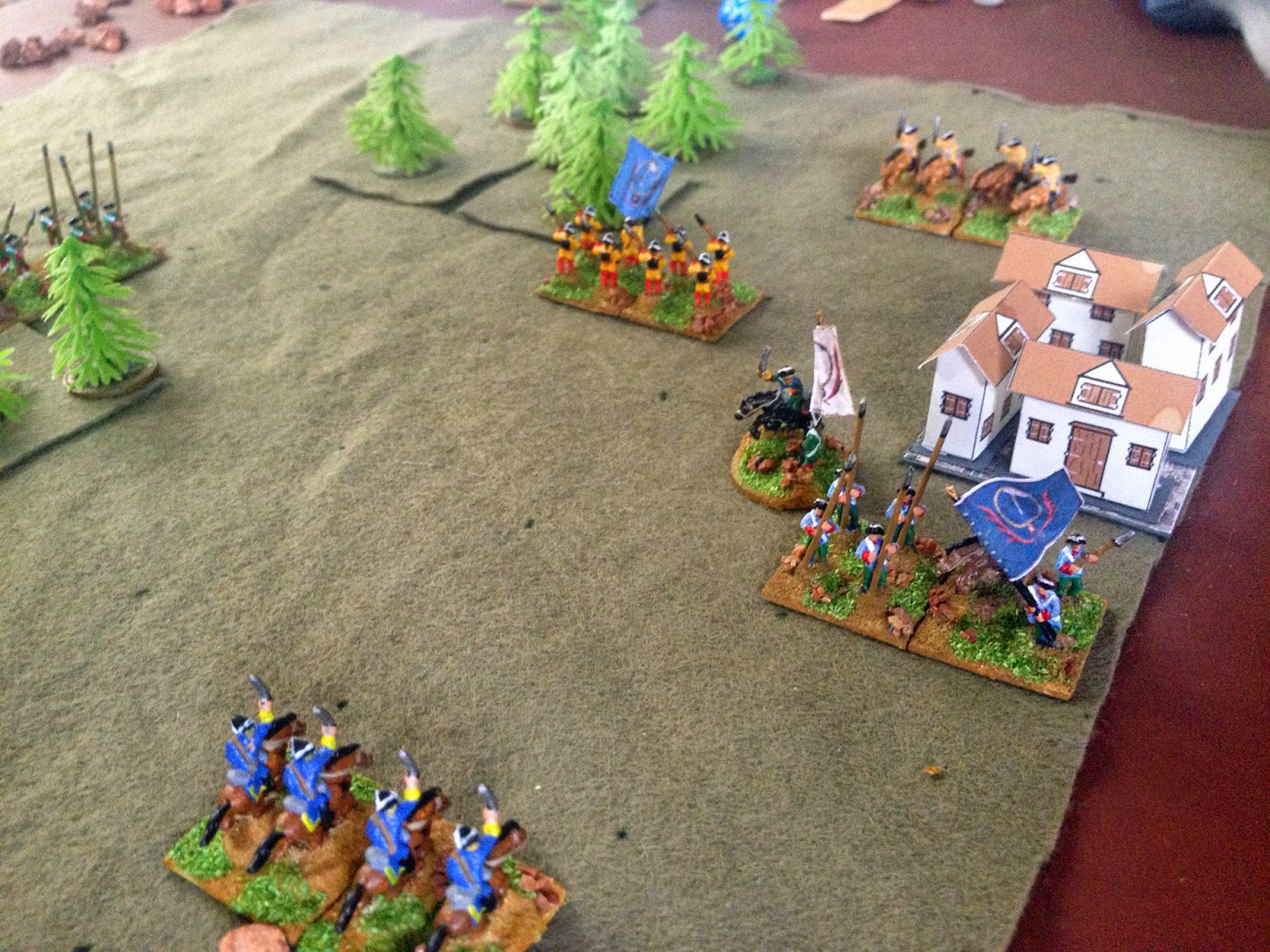I used the same campaign structure I used for the Missouri campaign I played out a couple of weeks ago, but with a prettier map. The Swedes had to advance from The Borders to The Heartland to The Gates of Moscow and then win a battle there to take Moscow itself. The Russians had to win three battles in The Borders. If there was no result after five battles then there would be a sudden-death playoff - the Fortified Defence scenario, representing in this case the Battle of Poltava.
The winner of a battle received a reroll token which could be used in subsequent battles. They also got to be the Attacker, which meant that they were allowed to choose which side they were in the next scenario after seeing the tactical situation. The Swedes started as attacker.
Caesar opted to be the Russians, and our first scenario was The Bridghead. One side has a bridgehead over a key river, and must extend and consolidate it. The other rushes troops from all points of the compass to prevent this. I chose to react to the bridgehead, so the Russians started with one unit on table, whilst I started bringing in reinforcements. My cavalry arrived first.
The battle developed as more troops arrived, but some poor initiative rolls meant that the Swedes hung back initially, whilst the Russians were able to push across the river.
The Russians were trapped between two Swedish infantry wings, with their backs against the river.
They held firm, and in the dying turns of the game all I could hope for was a furious attack to contest the bridgehead and force a draw.
The Russians drove me off, to win the first encounter.
Caesar now had the initiative as the Swedes tried to advance into Russia again. The next scenario was Counterattack. Caesar was defensing a small town on a road, whilst trying to take a bridge defended by a single enemy unit. But more Swedes were on the way, and could use the fords on each wing. The objective for both sides was to control both the bridge and the town.
Swedish artillery defended the bridge, and held off the Russian attack until reinforcements arrived.
My attacks on the fords stalled in the teeth of a dogged Russian defence, and the battle became focused on the bridge; with it looking unlikely that I could reach the town in time, I had to concentrate on holding the bridge in order to avoid another defeat. Caesar charged with his cavalry against the wavering artillery defenders.
His cavalry swept the Swedish artillery away, but they were unsupported, and a Swedish cavalry counterattack routed them at the first charge. This left Caesar's centre wide open and changed the game. All of his forces were now pinned at the fords on the flank, and the road to the town was clear. I pushed my cavalry along it to take the second objective, whilst his troops couldn't reach either in time. A last-minute victory for the Swedes saw me advance into the Russian heartland.
At one game each the initiative switched back to me. The next scenario was one of my favourites - An Unfortunate Oversight. I chose to be, once again, the defenders of a river-crossing, whilst Caesar's troop appeared to be attacking it but were, in fact, sneaking around a ford far out on my flank. It was a reverse of the Battle of Holowczyn.
Whilst the Swedes concentrated around the town to the right of the picture, the Russians move across the river to the left.
Artillery dueled across the river.
Both armies slowly formed up. The fighting swung back and forth ...
... but it was the Russians that eventually took and held the hill.
This second Russian victory pushed the Swedes back to the Borders space.
At that point we decided to call it a night, having played three games in three hours. After all, it will be easy enough to finish the campaign off another evening. We'd played three games in three hours, which was pretty good going. We decided to end there because it was impossible for the fourth game to be decisive - the campaign must either go to the fifth or sixth (and final) battle.
The modified rules held up well. The change such that dice which failed to activate units could be used to rally is especially interesting, forcing decisions as to whether to use units or rest them.
I picked six scenarios from the book to cover the first five games (so even the fifth would be a random pick). Three of them involve river crossings, and all three of them came up.
There were two other games on the go when we we playing all that.Firstly there was a big battle DBA game using the new 3.0 rules.
And, secondly, a game of BKC, with a modified refight of the Crossing the Narew scenario we played last year
Ralph - with burning tanks.




























































